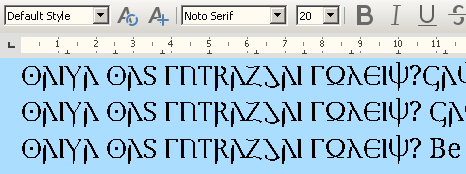I’m trying to type a bilingual English-Gothic document and the punctuation changes shape depending on the immediate adjacent character after it, be it a period, comma, colon, apostrophe, or any other punctuation mark.
If the text is Gothic and said character (highlighted in the pictures) is a space or Latin, the punctuation, in this case a question mark “?”, looks like this: ![]() and this:
and this: ![]() . This question mark appears to match the Latin letters in weight.
. This question mark appears to match the Latin letters in weight.
Now compare with this question mark which appears to be visibly lighter in weight, matching its adjacent Gothic letter: ![]()
The bolder Latin-matching question mark appears to be exactly like any font that is currently in use, while the lighter Gothic-matching one seems to be unchanged regardless of font, which I have tested. Any idea where the latter comes from and how to rectify this problem?
The language assigned to the text is English US. Using Windows 10 Pro x64, all settings in English US. LO version 6.1.6.3 x64.

